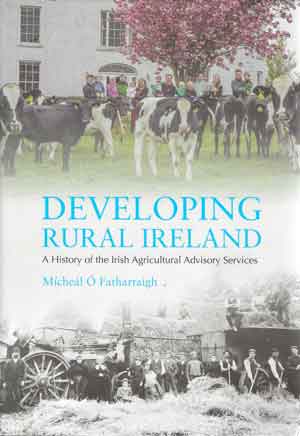DEVELOPING RURAL IRELAND
Published in Book Reviews, Book Reviews, Issue 2 (March/April 2023), Reviews, Volume 31A HISTORY OF THE IRISH AGRICULTURAL ADVISORY SERVICES
MÍCHEÁL Ó FATHARTAIGH
Wordwell Books
€30
ISBN 9781913934606
Reviewed by Trevor Storey
Trevor Storey was formerly a lecturer in Crop Science in the School of Agriculture and Food Science, UCD.
At first glance, the title of this book may be a little misleading to the casual observer, suggesting that it is solely ‘A history of the Irish Agricultural Advisory Services’. It is very much more than that. It is a comprehensive account of the development of Irish agriculture and how this paralleled the development of the advisory services.
An early reference to Arthur Young, who in 1776 began his survey of and residence in rural Ireland, gives an indication of life in Ireland at the time, followed a little later by the work of east Clare landlord John Scott Vandeleur. The Dublin Society, established in 1731 and later to be called the Royal Dublin Society, was anxious to raise the status of the agricultural population. It carried out agricultural experiments with the aim of improving the methodology of tillage farming and from 1741 offered premiums to encourage the purchase of farming equipment and pedigree livestock. The foundation of an advisory service was beginning to take place and the first agricultural instructor in Ireland was appointed in 1749, a British Quaker called John Cam. The first agricultural school, where farmers could learn agricultural techniques, was established at Bannow, Co. Wexford, in 1821.
Rural Ireland was then ravaged by the Great Hunger. In 1891 the Congested Districts Board was established and employed agricultural instructors to teach modern methods of cultivation and livestock-breeding, as well as to promote forestry. With the establishment of the Department of Agriculture and Technical Instruction (DATI) in 1899, every county in Ireland would get not just at least two university-educated agricultural instructors but also an instructor in horticulture and beekeeping and one or more instructors in poultry-keeping and butter-making. Each county council would organise a county committee of agriculture and technical instruction to complement the central institution and to spend the grant on the recruitment of agricultural instructors. The development of the advisory services through the years of the Emergency is comprehensively documented. The establishment of ACOT in 1980 and Teagasc more recently and the political debates surrounding their establishment are also well documented.
The job specification for instructors was broad and changed to reflect demands at a particular time—for example, responding in December 1916 to the first order for compulsory tillage. The advisory service was considered central to the success of the sugar-beet industry, with the establishment of the Irish state’s first sugar factory in 1926. Entry to the EEC in 1973 presented new challenges, particularly in the administration of the CAP (Common Agricultural Policy). As the author pointed out, ‘now more than ever, Irish farmers needed its instructors to be their guides, philosophers and friends’. There were more new challenges: milk quotas, super levies, the ‘green pound’, Agenda 2000—a whole new EU language.
Another first for the advisory service was the emergence of discussion groups: ‘Nothing better signified the substantive completion of the evolution of the agricultural instructor into the agricultural advisor than the emergence of discussion groups as the medium of knowledge transfer between advisors and farmers in rural Ireland’.
Environmental issues were now to the fore. Irish agriculture and rural Ireland were entering a period of profound change. The introduction of the Rural Environmental Protection Scheme (REPS) in 1994 would, according to the author, reinvigorate the advisory service. Intensive agriculture was perceived to be harmful to the environment. The participation of farmers in the REPS was without precedent in Ireland and these farmers would not have been able to participate successfully had it not been for assistance from advisors. The emergence of organic farming and the establishment of the Irish Organic Farmers’ and Growers’ Association in 1981 received official recognition with the establishment of an Organic Farming Unit (OFU) in the Department of Agriculture.
Climate change is now the single biggest threat and responding to it is the single biggest challenge to Irish agriculture and the advisory service. Responding to the crisis has turned so much of what was done previously on its head: ‘Had the twentieth-century’s advisors been told that their twenty-first-century counterparts might have to discourage increases in cattle numbers and fertilizer usage they would scarcely have believed it’.
It would appear that throughout all the events over the years the advisors had the confidence of the farmers, exemplified by this comment in 1911: ‘Another feature worthy of note is the tendency on the part of farmers to seek the Agricultural Instructor’s advice on market days before making a purchase’. Fast-forward to the 1980s, when many farmers were struggling to pay their debts. ACOT advisors, working with other farm organisations, held consultations with indebted farmers and drafted detailed financial plans for their recovery. ACOT advisors actually negotiated with lenders on behalf of farmers: ‘This is where they really exceeded their brief, going above and beyond their duty in the interests of farmers’.

















